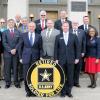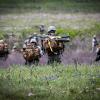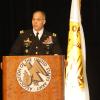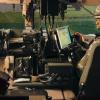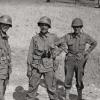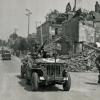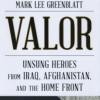The Army Chief of Staff’s Retired Soldier Council convened at the Pentagon from April 20-24 to review issues of concern to the retired community and advise the Army chief of staff, Gen. Raymond T. Odierno.During the council’s meeting, members discussed current and proposed Department of Defense policies that affect the retired community with 15 senior DoD officials.At the conclusion of the meeting, Lt. Gen. James J. Lovelace, USA, Ret., and Sgt. Maj. of the Army Kenneth O. Preston, USA, Ret., the council’s co-chairmen, discussed the members’ key proposals and concerns with Odierno.They also...
The U.S. faces a kaleidoscope of threats and needs a balanced, robust Army to address them, the president of the Association of the U.S. Army told the National Commission on the Future of the Army."Not only must we immediately stop the precipitous downsizing of the Army, but we must seriously consider growing all elements of the force to maintain an Army that we both need and can afford," said retired Army Gen. Gordon R. Sullivan, USA, Ret., president and CEO of AUSA and the 32nd Army chief of staff, as he testified June 18 before the eight-member commission.Sullivan said AUSA, which...
Far-reaching military retirement reforms proposed by the Military Compensation and Retirement Modernization Commission (MCRMC) in January 2015 have been largely adopted by Congress and DoD.The reforms include a pension reduction from 2.5 percent to 2.0 percent per year of service under the current High-3 retirement system.For retirees who serve 20 years, this would reduce annual pensions from 50 percent of their final basic pay to 40 percent. In addition, the MCRMC proposed the creation of a 401(k)-style investment account that would match up to 5 percent of base pay.DoD’s recently-released...
A senior Pentagon official is making the case for a massive overhaul of the military personnel system – from recruiting to promotions to tour length and duration of service – a move he describes as modernizing an aging set of rules and policies that are preventing the services from getting the most out of its people."We must have a personnel system worthy of our mission," said Brad R. Carson, undersecretary of the Army and acting undersecretary of defense for personnel and readiness, in a June 24 appearance before the Association of the U.S. Army’s Institute of Land Warfare.Carson heads an...
Reprinted by permission of The Hill Lasting scars to our nation’s national security are forming because of the continued political stalemate over spending priorities, including our financial commitment to defense.While some view the tug-of-war over the budget as a game of political brinksmanship, there are consequences from leaving the military adrift and undirected, not the least of which is a sense of unease bordering on irrelevance among the good, honest people who have dedicated themselves to military service.Good people are deciding to leave our military because they have lost confidence...
There is no doubt that communities will suffer under these reductions.(Army force reductions for fiscal years 2016 and 2017 will decrease the Army’s active component from 490,000 to 450,000 soldiers, and cuts Army civilian positions by 17,000.)Beyond the local economic impact, AUSA is on record as stating that an active component force of less than 490,000 presents unacceptable risks to America’s ability to protect our interests worldwide.This is especially true given that regional combatant commanders are asking for more land forces – not less – for engagement, exercises, training, advising...
The Army must be able to logistically execute at the tactical, operational and strategic level anywhere in the world in support of the maneuver commander, said Lt. Gen. Gustave F. Perna, the Army’s deputy chief of staff, G-4."We have nothing else to do but support the maneuver commander," said Perna, speaking at the Association of the U.S. Army’s Institute of Land Warfare Sustainment Hot Topic in June."Today," he said, "Nine out of 10 of our active duty divisions are committed. We are increasing our presence in Africa, South Korea, Iraq, Europe and Kuwait."Adding, "Any assumption that the wars...
My first job as a general was to write Certain Victory, the Army’s official story of the First Gulf War. My mission was the first of its kind: Deliver an operational history immediately after the war, drawn from the views of soldiers who had fought there. Gen. J.H. Binford Peay III, the Army Vice Chief of Staff at the time, told me to produce a printable version in one year. Volumes like these normally take at least a decade or more, but Peay wanted to get our message out ahead of the mountains of popular chronicles in the works. We also knew the Air Force was writing a similar book on the air...
With the third decade of the 21st century closing in, uncertainty and volatility have become dominant factors in the global threat environment. The things we can count on are few and, in their own ways, often open the door to even more unknowns. Taking today as a benchmark, U.S. forces likely will remain in high demand around the world—though we can’t predict exactly where or under what circumstances. Moreover, the Army’s operational tempo won’t change much; we will continue to work in joint, coalition and interagency settings. Our adversaries will become more sophisticated, and their access...
World War II dominated the Army’s identity for most of the half-century that followed the surrender of the Axis Powers. The American armed forces were led by veterans of that war through the 1970s. The decade-long war in Vietnam diminished the apparent value of the model but in the aftermath, the influence of World War II re-emerged through a younger generation of World War II veterans. The last of that breed, they played an important role in reconstructing and reorienting the post-Vietnam Army that closed out the Cold War. The legacy of that influence is felt today.Because armies are...
World War II dominated the Army’s identity for most of the half-century that followed the surrender of the Axis Powers. The American armed forces were led by veterans of that war through the 1970s. The decade-long war in Vietnam diminished the apparent value of the model but in the aftermath, the influence of World War II re-emerged through a younger generation of World War II veterans. The last of that breed, they played an important role in reconstructing and reorienting the post-Vietnam Army that closed out the Cold War. The legacy of that influence is felt today.Because armies are...
World War II was colossal, encompassing practically every corner of the Earth and every type of warfare, including urban combat, guerilla campaigns, information warfare, air-sea battles and conventional campaigns. War was messy, complicated and ugly then, and it still is. Studying World War II is as relevant to understanding modern conflict as reliving a firefight in Fallujah, pirate hunting in the Gulf of Aden or making a bomb run over Tripoli.Before the U.S. entered the conflict, the outcome was in grave doubt. Under the leadership of Adolf Hitler, Nazi Germany drew Great Britain and France...
While soldiers deep in the tropical jungle of Oahu, Hawaii, were learning survival, navigation and the importance of keeping dry when the 25th Infantry Division Tropic Lightning Academy’s Jungle Operations Training Center opened in 2013, the division’s cadre was learning a completely different lesson. They discovered one of those instances when less is more, because soldiers could absorb more from one-on-one instruction than being in large classes.Two years later, the jungle school in Hawaii has applied that lesson by limiting overall student population and class size while also becoming a key...
Nine Tales That Sing the Songs of Unsung Heroes By Col. Kevin C.M. Benson, U.S. Army retired
Nine Tales That Sing the Songs of Unsung Heroes By Col. Kevin C.M. Benson, U.S. Army retired


